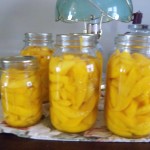Canning- When is it Safe?
I had to post this just because in recent weeks I have had several reports of unsafe canning. Not trying to be preachy here folks but you can make you or someone else sick if you don’t follow the rules. Having said that- if you do follow rules and use reliable recipes canning is safe.
The biggest misconception seems to be that as long as the jars sealed they are safe. NOT TRUE!!!! As long as you put hot food into a jar even a short processing time will likely seal the jars. That does not mean the foods inside were processed long enough to kill any possible pathogens. Some years back I had a lively conversation with one of my community gardeners because an out of date Blue Book said you canned green beans in a boiling water bath for 3 hours. She thought they had to be safe. Trouble is you can boil the beans for 3 days the water in a boiling water bath will not go over 212 degrees F. The spores for botulism are killed at 220 degrees.
Lets talk about the 2 basic kinds of approved methods: water bath and pressure canning. A boiling water bath is for fruit products ( juices, jellies , jams etc.), pickled products and tomatoes if the have been acidified. Pressure canners are used for non-pickled vegetables, convenience foods like soup and chili, meat, poultry and fish.
A water bath canner requires jars to be completely submerged in the water and covered to a depth of 1-2 inches over the jars. The water should be boiling when you add the jars to the canner and processing timing starts when water returns to the boil. In the case of pickles processing is done when water is at a simmer. Don’t short the time and if you live at higher elevations ( over 1,000 ft.) processing times are longer. When the time is up remove the jars and allow them to cool down out of drafts.
Pressure canners differ somewhat in their directions. Some require 3-4 inches of boiling water in the canner and others require a specific amount of water. Follow the directions that came with your canner. Jars are placed in the canner with the boiling water and it is closed. Under high heat the canner must be vented for 10 minutes and then fitted with a gauge to register the internal pressure- usually 10 pounds. timing starts once the canner reaches pressure. Once it has reached pressure you can turn the heat down. Maintain enough heat to keep it at pressure but not to go over. Once the time is up the canner is removed from the heat and allowed to cool until a vent- that will have popped up after the canner was vented- falls down naturally. This can take 30 minutes or even up to an hour. Once the vent has dropped you wait one more minute then remove the lid- opening it away from you as it will still be very steamy in the canner. Now the jars can be placed on a counter to cool. You can’t rush the process by placing the canner in cold water. You just have to wait.
The sound of the jars “plinking” will let you know they are sealed. Following the correct times and procedures will assure you that they are safe.
Remember- use reliable recipes-follow the times- ask for help if you aren’t sure. I love to can and promote it all the time. It worries me to think that someone could get ill or lose their stored foods through spoilage when all they had to do was change a few practices. Be safe people!!!





